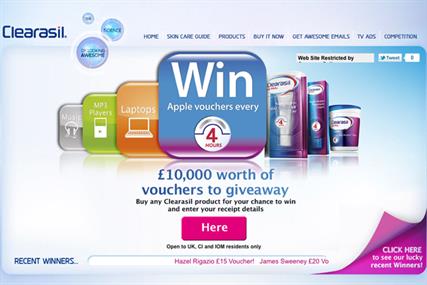Reckitt Benckiser (RB) is one of the U.K.’s largest fast-moving consumer goods manufacturer; they are responsible for hundreds of well-known brands such as Dettol, Strepsils and Cilit Bang. This post, however, will be focusing on just one of their many brands: Clearasil. RB has just launched a new promotional campaign to boost awareness and sales of their spot removal and skin care brand. With any Clearasil purchase, customers can visit their website and enter in their receipt details for the chance to win Apple vouchers.
This is a great example of a market penetration strategy; whereby marketing efforts are focused on increasing sales of existing products to their current customers. And I actually think this simple marketing push – they have only had to adjust ‘Promotion’ element of their marketing mix – is really effective. There are essentially two reasons why I like this campaign enough to write-up about it:

Firstly, they aim to encourage teenagers – the target market – to try using Clearasil products. But the offer also appeal to existing customers, who have already tried the product and are regular users, as well. Market penetration works by increasing consumption of a product. Hence, it would not be a surprise if regular users take the opportunity to stock up product for a chance to enter the competition – maybe even more than once. This is effective, yet simple marketing: the customer is happy to win vouchers and the company receives more sales. Therefore, a profitable relationship has been established.
Secondly, they have segmented and targeted their consumers; and this is clearly seen in their strategy. I like the idea of giving away Apple vouchers every four hours. According to the managing director of the agency who created RB’s promotional campaign, this emphasises the rapid four-hour improvement Clearasil provides. Moreover, the moving banner at the bottom of the page highlights recent winners. These two ideas give a real sense of having a chance to win; rather than having just one, high-value prize that many competitions offer. Evidently, they really understand exactly what it is that their consumers want. This is why I believe market segmentation and targeting to be essential to any strategy – regardless of how complicated or simple it may be.
Ultimately, I the point I am trying to make with my post is this: marketing strategies do not have to be fancy or complicated to be effective. What is needed for a strategy to work is to clearly understand your consumer and then, hopefully, all that is needed are subtle changes to the marketing mix. RB have built some of the U.K.’s most recognisable brands – they clearly know what they are doing… and it is not rocket science!
Do you personally feel inclined to try Clearasil because of the competition? Or if you are a regular user would you use this as a chance to stock-up? Please leave a comment below.
© Joshua Blatchford, author of Manifested Marketing, 05/08/2011



